
No.10 FILTER SEPARATOR CONTROLS - PART 1 "AUTOMATIC CONFUSION" APRIL 1976 - Revised November 1996
There are probably no more that 5 GamGram readers in the entire world who already know how to troubleshoot each of the various brands of separator controls. How many times have you stood beside a filter and wondered how to find which pilot valve is not operating correctly. With at least 5 different brands of valves on the market, you need to carry a library with you!
This writer has stumbled his way his way through many a troubleshooting expedition and was embarrassed one too many times by lack of needed information. To solve this problem, data on all known valves were collected and tabulated. The exceptional cooperation of each manufacturer is acknowledged. We have not included in this study the single circuit controls that are used on mobile equipment.
The diagram in Figure 1 shows the control system. The primary control is the float operated pilot valve. The float is weighted so that it floats on what but not on fuel; it rides on the interface between water and fuel. Table 1 shows that the drain valve opens as water collects but if water gathers faster that it can drain out, the discharge valve closes until the water level is again safe.

Each manufacturer uses 4 different ports on their float operated pilot valves. These ports are marked differently by each manufacturer and one (Smith) has no marks at all. In Table 2 we have used identifying letters and numerals that refer to clock positions, e.g. the water drain connection port is at the 2 o'clock position.
NOTE: In the 1996 revision, this figure has been revised for clarification.

To troubleshoot a system you must know which ports should be vented and which should be pressurized under various conditions. Table 3 shows this for each brand. F-S, W-D means for CLa Val the port F is internally connected to port W is internally connected to port D. In other words, if you blow air in port F, it will come out of port S. Air into port D comes out of port W.

All of the standard side and bottom mounted float pilot valves operate according to the table with one exception. The Cla Val 1626AF bottom mounted combination float pilot and automatic drain has no visible supply, water drain valve or vent ports so it must be bench checked with air to troubleshoot.
Suppose you have a Smith system and are experiencing a consistent fuel leak through the water drain line when you know the float is down. Disconnect the vent tube to see it if is the source. If so, you know the float valve has a bad seal, allowing fuel to leak into the vent port. If the vent does not leak, you can conclude that the water drain valve seal has failed or is held open by dirt particles.
If the same problem occurred with a Cla Val system, a leak at the vent could be in the float pilot but because F and D are connected, you must disconnect tube F to see if the fuel is coming from the ON-OFF control pilot on the discharge valve. If not, you can conclude that the drain valve seal has failed or is dirty.
Table 3 is especially useful when you are trying to analyze faulty operation. For example, the discharge valve fails to open in a Smith system. Table 3 shows that 5 and 9 are connected so if you loosen a fitting on the tube that runs from the float operated pilot valve to the discharge valve you should have fuel pressure coming from the float operated pilot valve. If you find that the line is pressurized, you can conclude that the trouble is at the discharge valve, not at the float operated pilot.
We want to make a final point about automatic drain valves. in our opinion, they are not totally reliable. We mean that there can be a massive spill if one sticks in the open position because a foreign object becomes caught in the valve seat. We recommend that they not be used. To deactivate an automatic drain valve, plug the water drain port on the float pilot of all brands. However, in the case of Cla Val, the automatic water drain valve must also be removed completely.